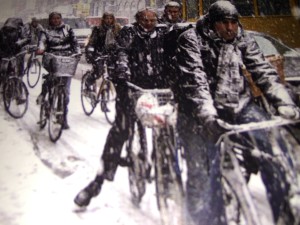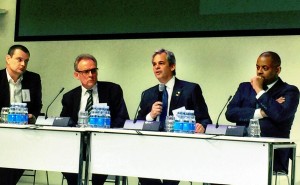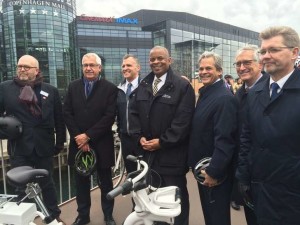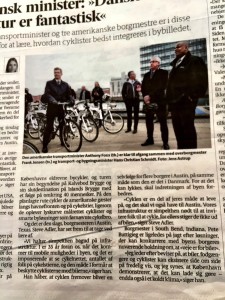 By Steve Adler
By Steve Adler
We just left Copehagen, Denmark, on our innovation exchange trip for the Smart City Challenge, and the deep immersion in all things mobility prompted me to share some thoughts with you. Clearly, increased mobility is a tool to help improve quality of life – directly in terms of minimizing congestion and indirectly to help mitigate runaway housing costs, gentrification, economic segregation, and even things like disparate health outcomes by zip codes.
I also want to explain this picture that’s posted above, but I’ll get to that below.
We’ve spent lots of time in casual and theoretical conversations with Anthony Foxx, the Secretary of Transportation, and fellow mayors – always ending with very practical applications. The Secretary used to be a mayor himself (in Charlotte, North Carolina) and he talks about municipal government being the level of government where citizens expect real action and results.
The focus in Denmark was been examining more efficient use of existing right of way – with efficiency defined as moving the greatest number of people most quickly with the least congestion. How we can accomplish this is a “do or die” challenge for Austin. The reason I’m here is to see how other cities have solved the same problem. Denmark has done this in a significant way with bicycles.
In my head,  I immediately see myself and so many others in Austin smile – Texans are not like Danes. Bicycles, I can hear people say, are not a solution that will work at scale in Austin. What works here could not work at home… yet… in the ‘70s Denmark had an auto-centric population just like in Austin does now. Back then, Copenhagen made a tough (and, as it turns out, smart) decision to decision to prioritize a different way to get around town. Today, bike users represent 50% of Copenhagen’s commuter traffic. I’ve seen people biking to work in work clothes… skirts and suits. (At least, I hope they are biking to work. Otherwise, they are horribly overdressed.) They bike in sun, rain, and snow, which is what that photograph above is of. Those are actual commuters in Copenhagen. On bicycles. In the snow. They bike with box carriers on the front for returning from grocery
I immediately see myself and so many others in Austin smile – Texans are not like Danes. Bicycles, I can hear people say, are not a solution that will work at scale in Austin. What works here could not work at home… yet… in the ‘70s Denmark had an auto-centric population just like in Austin does now. Back then, Copenhagen made a tough (and, as it turns out, smart) decision to decision to prioritize a different way to get around town. Today, bike users represent 50% of Copenhagen’s commuter traffic. I’ve seen people biking to work in work clothes… skirts and suits. (At least, I hope they are biking to work. Otherwise, they are horribly overdressed.) They bike in sun, rain, and snow, which is what that photograph above is of. Those are actual commuters in Copenhagen. On bicycles. In the snow. They bike with box carriers on the front for returning from grocery  stores and shopping – and even for taking little ones to school and older ones to health checks.
stores and shopping – and even for taking little ones to school and older ones to health checks.
Today, the most congested roads in Copenhagen are not for cars but paths and trails for bikes.
Of course, such massive conversion to bicycles is a far-fetched idea for Austin. Just like it was for Copenhagen.
PS – One more thing. I wanted to share a photograph of the article in the Copenhagen newspaper that ran about our visit. If you look closely, you can see that I’m quoted over a few paragraphs. As you’ll note, my Danish has gotten quite good in just a couple days.
 If you want to read something more in English about this fact-finding mission for the Smart City Challenge, here’s what the Department of Transportation ran on its blog about the intersection between innovation and urbanization, and here’s what was published in the Austin Business Journal. Also, if you haven’t read the great oped by Barbary Brunner and Molly Young of the Austin Technology Council about the terrific opportunity that the Smart City Challenge offers not only to Austin’s tech community but also to those who usually don’t benefit from tech, read it now.
If you want to read something more in English about this fact-finding mission for the Smart City Challenge, here’s what the Department of Transportation ran on its blog about the intersection between innovation and urbanization, and here’s what was published in the Austin Business Journal. Also, if you haven’t read the great oped by Barbary Brunner and Molly Young of the Austin Technology Council about the terrific opportunity that the Smart City Challenge offers not only to Austin’s tech community but also to those who usually don’t benefit from tech, read it now.
As always, please be sure to use the #DOTSmartCity hashtag so the folks up in Washington (who are going to make the decision about who wins the Smart City Challenge) know what people in Austin think about the opportunity to use technology to make mobility safer, cheaper, cleaner, and more effective for everyone.

2 comments
Comments are closed.